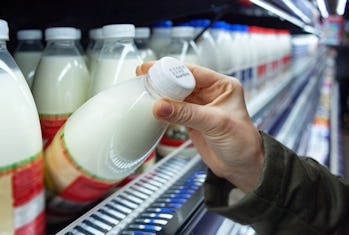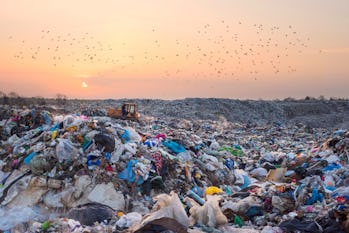HIDDEN ON THE EDGE of lids or on the underbelly of containers, the ‘best by’ or ‘sell by’ dates of grocery store food can be a mysterious — and menacing — source of tension in a home kitchen.
Like a ticking time bomb, these labels promise us that destruction (or at least spoiled food) awaits us just around the corner. However, a peek under the hood of these labels reveals that they have much more to do with how food looks and tastes than whether or not it's actually spoiled.
Londa Nwadike, an associate professor of food safety for both Kansas State University and the University of Missouri, and Elisabeth Anderson, director of science communications for Michigan State University’s Center for Research on Ingredient Safety, help Inverse explore the unregulated wild west of food labels and explain how to know if your food has actually gone bad.
WHAT DO ‘BEST BY’ DATES REALLY MEAN?
When sauntering through the grocery aisles you’ve probably noticed a wide variety of food labels stamped onto your food including an item’s “best by,” “sell by,” or even “freeze by” date.
These labels might seem opaque to many consumers but Anderson tells Inverse they actually have very specific meanings to the manufacturers creating them — and almost none of those meanings are actually related to spoiled food.

You may want to instinctually toss your milk or cheese after it has passed its “best by” date, but that label actually has nothing to do with food expiration.Shutterstock
“Currently, there’s no industry standard for best by, sell by, or use by dates,” Anderson explains.
“Generally speaking, these dates refer to when the manufacturer believes the products will be at peak flavor, freshness, and quality.”
Anderson says that labels including “best if used by/before,” “use by,” “sell by,” “freeze by,” and “guaranteed fresh” are all quality deadlines (as in, when food might taste or look its best) and not true expiration dates that would denote spoilage or dangerous food.
The only exceptions to this rule are labels like “expiration” or “EXP” which are found on infant formula and do refer specifically to product expiration. “Use by” can have a similar meaning when found in infant formula as well.
“IT’S BETTER TO BE SAFE THAN SORRY.”
Nwadike tells Inverse baby formula is one of the only food groups to receive this kind of scrutiny and regulation when it comes to expiration dates because the nutritional content of the formula may change over time, making it less useful to feed to a baby.
“If it's consumed after that date, then your infant's probably not getting the nutrition that they need,” Nwadike says.
She also adds that labels like “sell by” may also be used internally at grocery stores to make sure there’s a constant flow of stock in and out of the store.
WHO CREATES ‘BEST BY’ DATES?
A huge part of why these labels can be so confusing to consumers is because there’s no standardization put in place by the FDA or USDA to regulate these labels, Anderson explains. In fact, it’s up to the manufacturers themselves to decide what gets labeled as “use by” or “best if before” and what that actually means.
This doesn’t necessarily mean the companies are behaving nefariously (though, it can’t be ruled out across the board either) but instead often comes down to an issue of failed science communication between food scientists and the public, Anderson says.
“To a trained food scientist, they may choose the ‘use by’ date for very specific reasons, based on a whole bunch of research that they very specifically know — but nobody else knows that,” says Anderson. Scientists are not “intending to cause confusion, it’s more so just the way that they were trained.”
But just because these labels aren’t created necessarily with food spoilage in mind doesn’t mean that there’s no rigorous testing and food science happening behind the scenes to create them, explains Nwadike. For example, manufacturers will do pathogen testing, taste testing through a product's lifetime, and even calculation-based simulations to determine when these foods will be at their prime.

Foods like milk will give off strong clues about when it’s finally time to discard them, including changing taste, odor, and texture.Shutterstock
HOW LONG CAN YOU EAT FOOD PAST ITS EXPIRATION DATE?
Because these food labels really have nothing to do with food’s true expiration date, both Anderson and Nwadike say that it can be safe to eat food even after this date — with a small dose of caution.
Anderson says there are some clues you can use to determine if your food has gone bad. These revolve around looking for changes in:
Color
Texture
Consistency
Odor
Taste
While it may seem worth it to risk consuming an extra-funky piece of cheese or chugging through a sour glass of milk, Nwadike says it can be impossible to know when a foods’ off-taste is simply from bad odor excreting “spoilage” microorganisms or a more dangerous pathogen like salmonella or E. coli. Consuming these pathogens could cause you some GI distress (e.g. vomiting, diarrhea) and even land you in the hospital if you’re not lucky.
“We always say ‘when in doubt, throw it out,’” says Nwadike. “It’s better to be safe than sorry.”
Anderson also recommends using the food safety app FoodKeeper to help guide you when making the final decision to eat, toss, or even freeze your food. Another hack: Nwadike says that adding just off milk to a warm dish, like pudding, can be a way to safely consume it up until its final days because heat will often kill off any pathogens that may have sprung up.
HOW ‘BEST BY’ DATES INFLUENCE FOOD WASTE
More than being just a headache for consumers, the confusion around food expiration dates is also a major source of food waste in the U.S. The FDA estimates like about 20 percent of food waste can be attributed to confusion over food labels and consumers tossing “expired” food that is actually still good to consume.
This creates a harmful food production cycle where resources are used and emissions are created to make food that is never consumed. Not only is this bad for the planet but it’s also a harmful cycle that impacts those experiencing food insecurity as well.

Throwing out your month-old cereal “just in case” may seem like a small action, but this food label confusion has led to a massive food waste problem.Shutterstock
“The waste problem has spurred action from industry, government, and non-governmental organizations to work together to try and tackle the confusing labels,” Anderson says. “They are working to streamline language and eventually marketing efforts to raise consumer awareness on how to understand and use date label information. However, it’s a voluntary and ongoing process.”
It’s also a process that has been put on the backburner during Covid-19, she adds.
In lieu of sweeping standardization of these food labels, Anderson and Nwadike say it’s important to get the message out to consumers — through media like cooking shows or through community education efforts. In addition to helping consumers parse the label language itself, these programs could also help consumers understand how conditions in their own home (like fridge temperature or counter cleanliness) can impact the shelf life of their products too.
Shifting the public consciousness on this topic is easier said than done, but it could help reduce a huge source of waste in the country.
Sem comentários:
Enviar um comentário
1) Identifique-se com o seu verdadeiro nome e sem abreviaturas.
2) Seja respeitoso e cordial, ainda que crítico.
3) São bem-vindas objecções, correcções factuais, contra-exemplos e discordâncias.